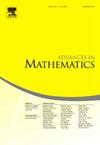Almost sure dimensional properties for the spectrum and the density of states of Sturmian Hamiltonians
IF 1.5
1区 数学
Q1 MATHEMATICS
引用次数: 0
Abstract
In this paper, we find a full Lebesgue measure set of frequencies such that for any , the Hausdorff and box dimensions of the spectrum of the Sturmian Hamiltonian coincide and are independent of α. Denote the common value by , we show that satisfies a Bowen's type formula, and is locally Lipschitz. We also obtain the exact asymptotic behavior of as λ tends to ∞. This considerably improves the result of Damanik and Gorodetski (Comm. Math. Phys. 337, 2015). We also show that for any , the density of states measure of is exact-dimensional; its Hausdorff and packing dimensions coincide and are independent of α. Denote the common value by , we show that satisfies a Young's type formula, and is locally Lipschitz. We also obtain the exact asymptotic behavior of as λ tends to ∞. During the course of study, we also answer or partially answer several questions in the same paper of Damanik and Gorodetski.
图尔米安哈密顿量的谱和态密度的几乎确定的维度性质
在本文中,我们找到了一个频率I´[0,1]∈Q的完整Lebesgue测度集,使得对于任意(α,λ)∈I´x[24,∞),Sturmian哈密顿函数Hα,λ,θ的频谱的Hausdorff维数和box维数重合并且与α无关。用D(λ)表示公共值,我们证明了D(λ)满足Bowen型公式,并且是局部Lipschitz。我们还得到了D(λ)在λ趋于∞时的确切渐近性质。这大大提高了Damanik和Gorodetski (Comm. Math)的结果。物理学报,337,2015)。我们还证明了对于任意(α,λ)∈I φ x[24,∞],Hα,λ,θ的态测度的密度是精确维的;它的豪斯多夫尺寸和填料尺寸重合并且与α无关。用d(λ)表示公共值,我们证明d(λ)满足Young型公式,并且是局部Lipschitz。我们还得到了d(λ)在λ趋于∞时的确切渐近性质。在学习过程中,我们也回答或部分回答了Damanik和Gorodetski在同一篇论文中的几个问题。
本文章由计算机程序翻译,如有差异,请以英文原文为准。
求助全文
约1分钟内获得全文
求助全文
来源期刊

Advances in Mathematics
数学-数学
CiteScore
2.80
自引率
5.90%
发文量
497
审稿时长
7.5 months
期刊介绍:
Emphasizing contributions that represent significant advances in all areas of pure mathematics, Advances in Mathematics provides research mathematicians with an effective medium for communicating important recent developments in their areas of specialization to colleagues and to scientists in related disciplines.
 求助内容:
求助内容: 应助结果提醒方式:
应助结果提醒方式:


